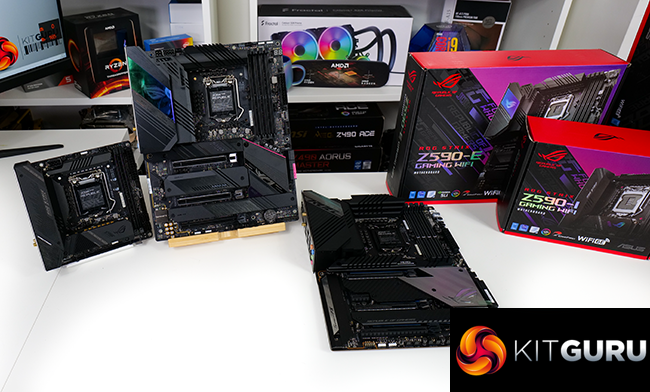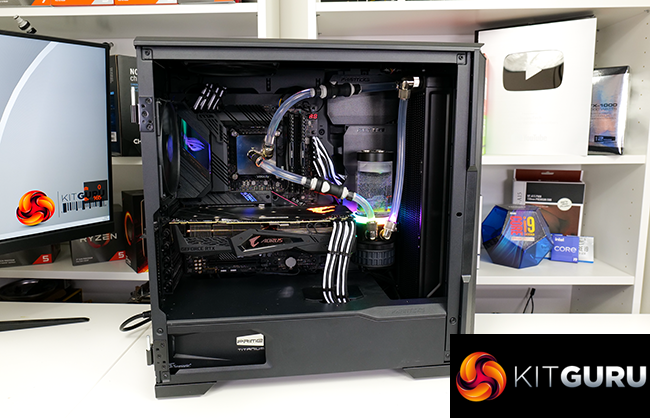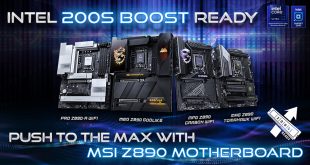As you will see in our video review, the XMP / Adaptive Boost bug in the BIOS is frustrating, especially on such an expensive motherboard that bares the ROG branding. We notified ASUS of the issue and have absolutely no doubt that it will be fixed with a BIOS update. Try our manual memory speed workaround if you are experiencing similar issues.
All boards offer Intel 2.5GbE and WiFi 6E connectivity which is great to see for current and future high-speed networking support. Good job ASUS on that one – it is positive to see high-speed networking being taken seriously for today's market.
ROG STRIX Z590-I Gaming WiFi (ITX)
ASUS' ITX board uses a high quality power delivery solution with solid cooling capability for Mini-ITX. I don’t personally like VRM fans, but this was unobtrusive and is a good backup measure for dealing with power-hungry Intel chips.
The motherboard is a smart overall design with few complaints. That M.2 daughterboard is a good piece of innovation but I personally didn’t find it all that convenient in terms of installation. There are certainly benefits to having both SSDs on the front side, especially as both can be cooled by ASUS’ metal strips. But I found the installation procedure to be a bit fiddly.
I wasn’t impressed by the rear IO. There were not enough high-speed USB Type-A ports – more than 2 USB 2.0 ports is silly in today’s market. But 20Gbps USB-C and Thunderbolt 4 connectivity are excellent inclusions. As is the future-proofed WiFi 6E connectivity that is likely particularly important for ITX going forward.
The ROG STRIX Z590-I Gaming WiFi is very expensive at £320 and perhaps a little difficult to get too over-excited about given the relatively limited appeal of the Z590/11th Gen platform at the high-end. The board is a solid offering if you must have Mini-ITX Z590 and will use Thunderbolt. Though MSI in particular offers a tough competitor in the UNIFY.
ROG Maximus XIII Hero (ATX)
The high-end ROG Maximus XIII Hero is overkill in so many respects. The power delivery solution is absurdly high-end and features a particularly strong cooling design. Dual TB4 ports on the rear IO offers plenty of high-speed connectivity to users who actually want it.
It is also good to see greater emphasis put on enthusiast and tweaker features such as onboard power buttons, water cooling connections, and more high-bandwidth USB connectivity.
Perhaps the lack of 5G or 10G networking is one of the few downsides of this premium – and very expensive – Z590 motherboard. £460 really is a tough price to swallow, but to ASUS does offer a very healthy set of components to a user who is adamant on going for high-end Z590.
ROG STRIX Z590-E Gaming WiFi (ATX)
The ROG STRIX Z590-E Gaming WiFi is the one board in particular that I liked from this round-up. The overall hardware choices are sensible, the design is attractive yet functional, and there are quality innovation touches such as the tool-less M.2 retention clip.
I feel like the downgraded power delivery solution and overclocking features versus the Hero are a non-issue to most users. And the lack of TB4 will likely be irrelevant to many non-productivity buyers. The bigger positive is the price reduction of around £120 versus the Hero while ASUS is still offering a quality board overall.
With that said, there are a couple of cheaper ROG STRIX boards around the £300 mark that offer much of the same core features and connectivity of the Z590-E. And that’s without even mentioning competing vendors’ solutions.
But, if you have a reason to go for a high-end Z590/Rocket Lake build, I feel like the ROG STRIX Z590-E Gaming WiFi is a good motherboard at a somewhat sensible upper-mid-range price point. Especially if you value the subtle networking and RGB upgrades versus its cheaper brothers.
The ASUS ROG STRIX Z590-I Gaming WiFi is priced at £329.99 at Overclockers UK. The ASUS ROG STRIX Z590-E Gaming WiFi is priced at £339.95 at Overclockers UK. The ASUS ROG Maximus XIII Hero is priced at £459.95 at Overclockers UK.
Discuss on our Facebook page HERE.
ROG STRIX Z590-I Gaming WiFi (ITX)
Pros:
- Solid VRM solution with good cooling for Mini-ITX
- Smart daughterboard design
- TB4 and 20Gbps USB 3.2 Gen 2×2
- High-speed Intel networking
Cons:
- Bad rear IO USB Type-A configuration
- Extra or higher current fan headers would be welcomed
- Very expensive
KitGuru Says: A premium SFF Z590 offering that performs well but also has stiff competition and is expensive.
Score:
ASUS ROG Maximus XIII Hero:
Pros:
- Excellent power delivery system with a massive cooling block
- Good to see onboard power and reset buttons for overclockers
- Beefed up M.2 cooling heatsinks
- Dual Thunderbolt 4 ports for access to the superb, high-speed ecosystem
Cons:
- 5GbE or 10GbE connectivity would have been justified
- Expensive even versus some of its competitors
- Quirks with XMP and Adaptive Boost in our testing were a little frustrating
KitGuru Says: Overkill in so many respects, the ROG Maximus XIII Hero is a very appealing high-end Z590 offering with an equally high-end price tag.
Score:
ASUS ROG STRIX Z590-E Gaming WiFi:
Pros:
- Robust, well-cooled power delivery solution with a fan upgrade option
- Innovative installation method for some of the four M.2 SSD slots
- Smart allocation of bandwidth to allow for ample expansion capability
- Excellent rear IO connectivity including dual 2.5GbE and WiFi 6E
- Easy-to-use UEFI with solid fan speed control
Cons:
- Higher current fan headers would be welcomed, although quantity is superb
- Quirks with XMP and Adaptive Boost in our testing were a little frustrating
KitGuru Says: The ROG STRIX Z590-E Gaming WiFi offers a host of worthwhile features and does so for a reasonable price increase versus its lower end siblings.
Score:
 KitGuru KitGuru.net – Tech News | Hardware News | Hardware Reviews | IOS | Mobile | Gaming | Graphics Cards
KitGuru KitGuru.net – Tech News | Hardware News | Hardware Reviews | IOS | Mobile | Gaming | Graphics Cards







